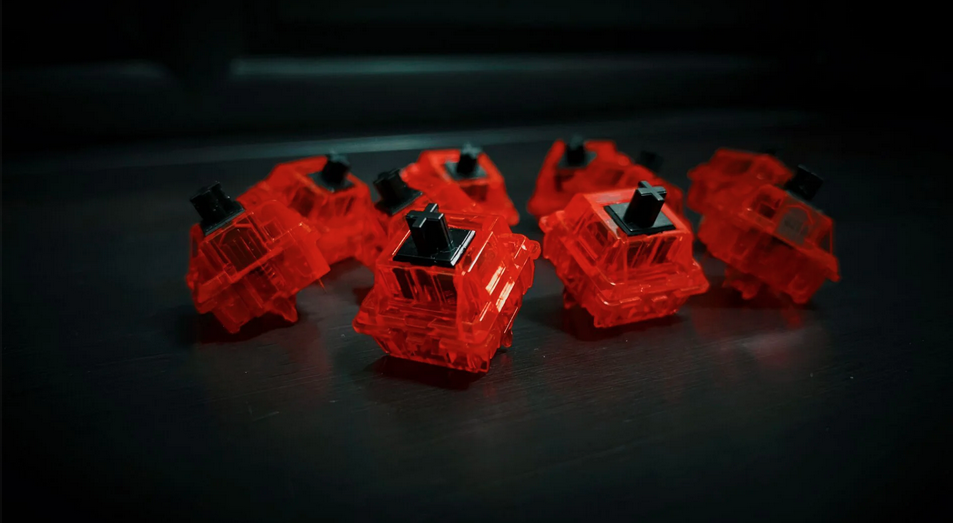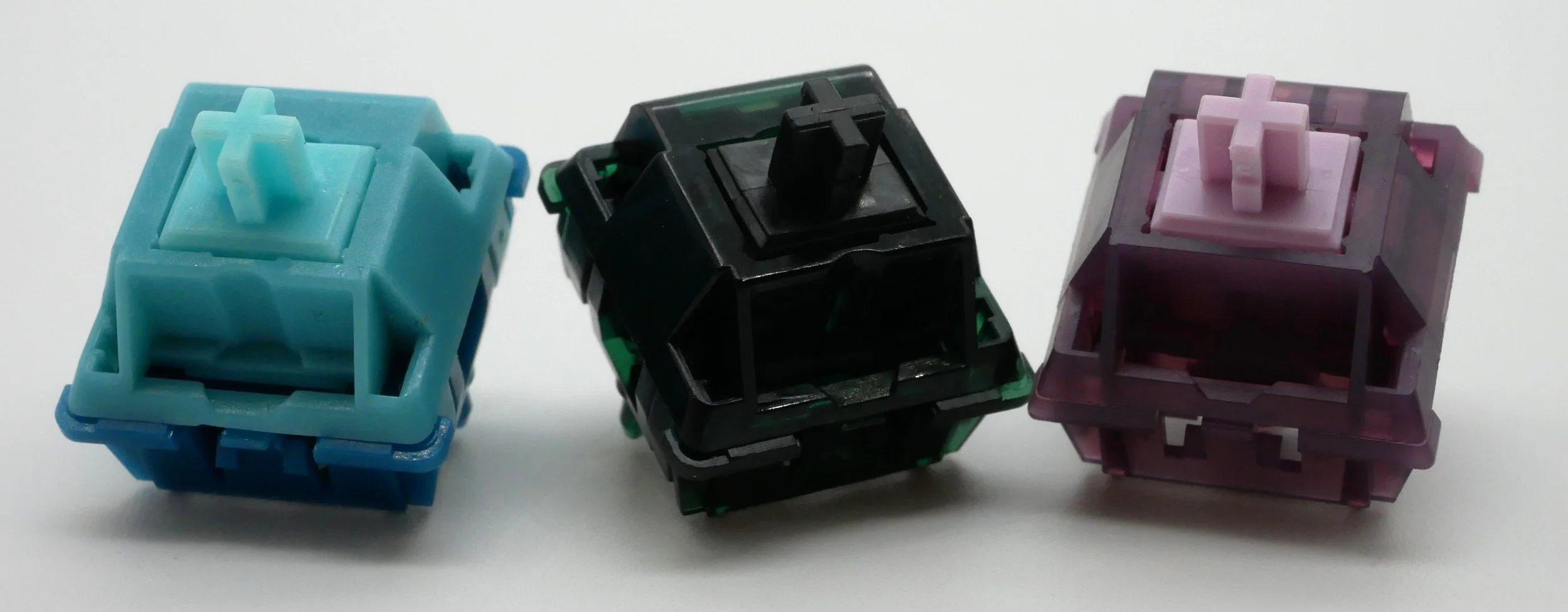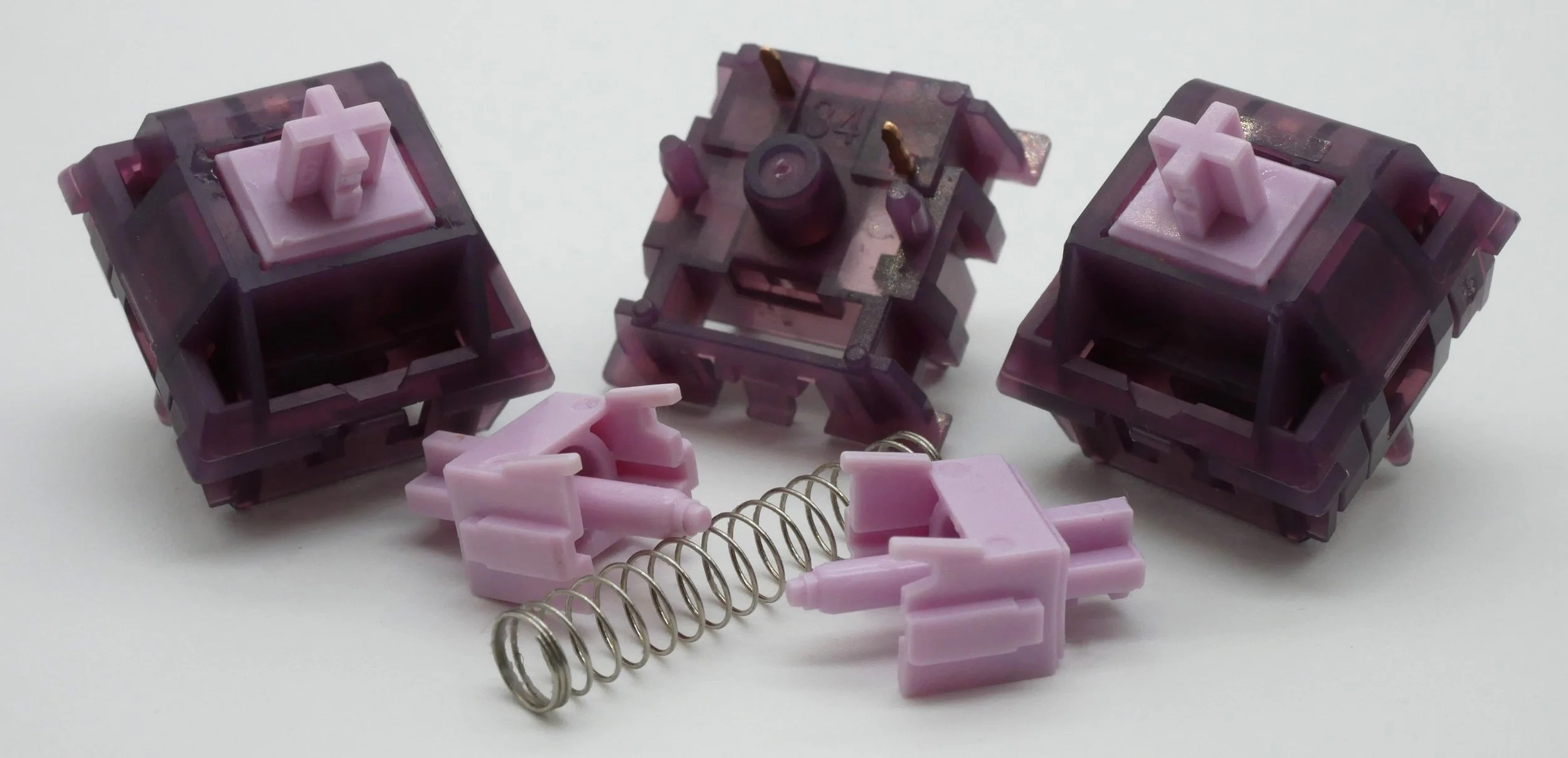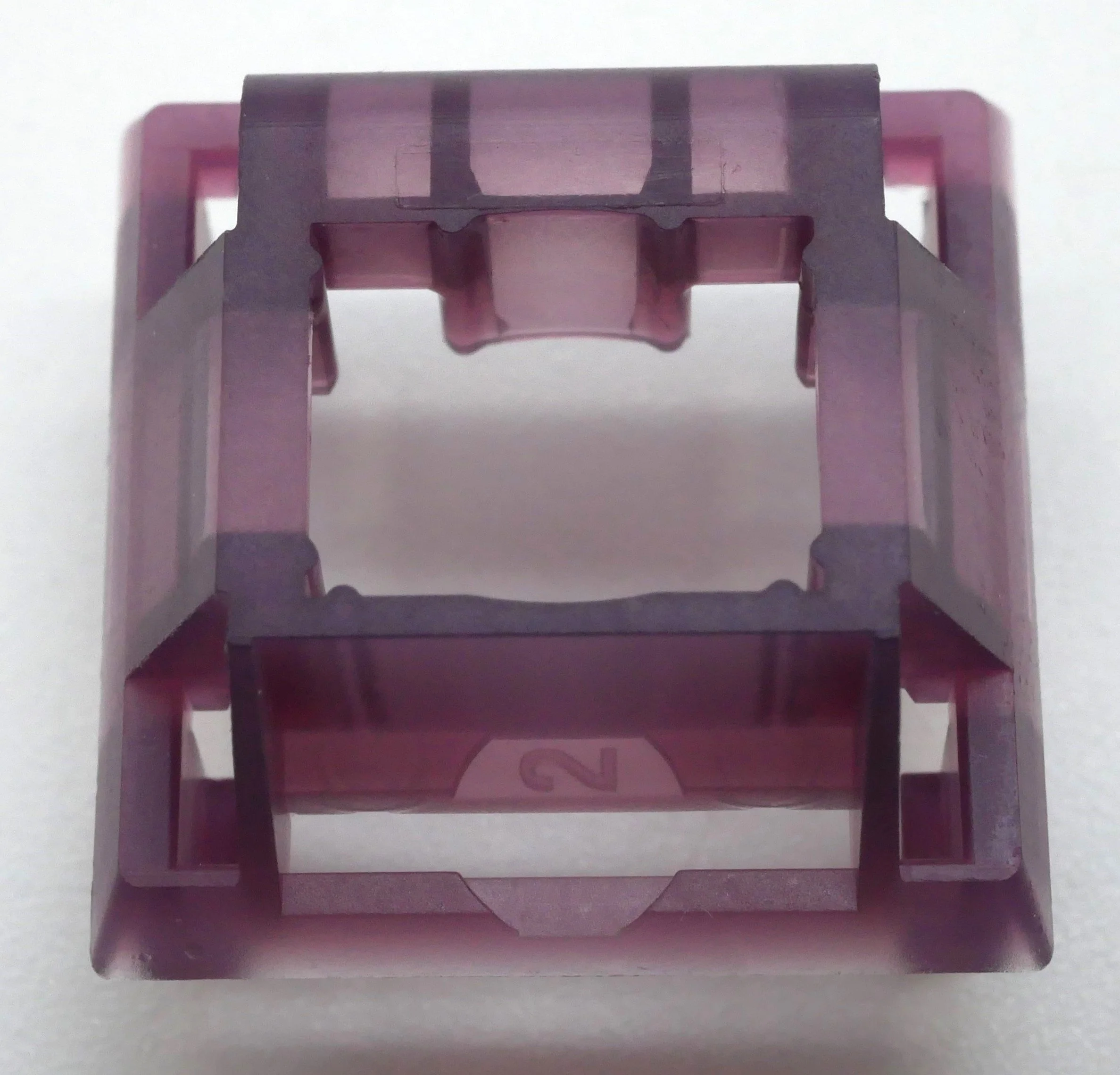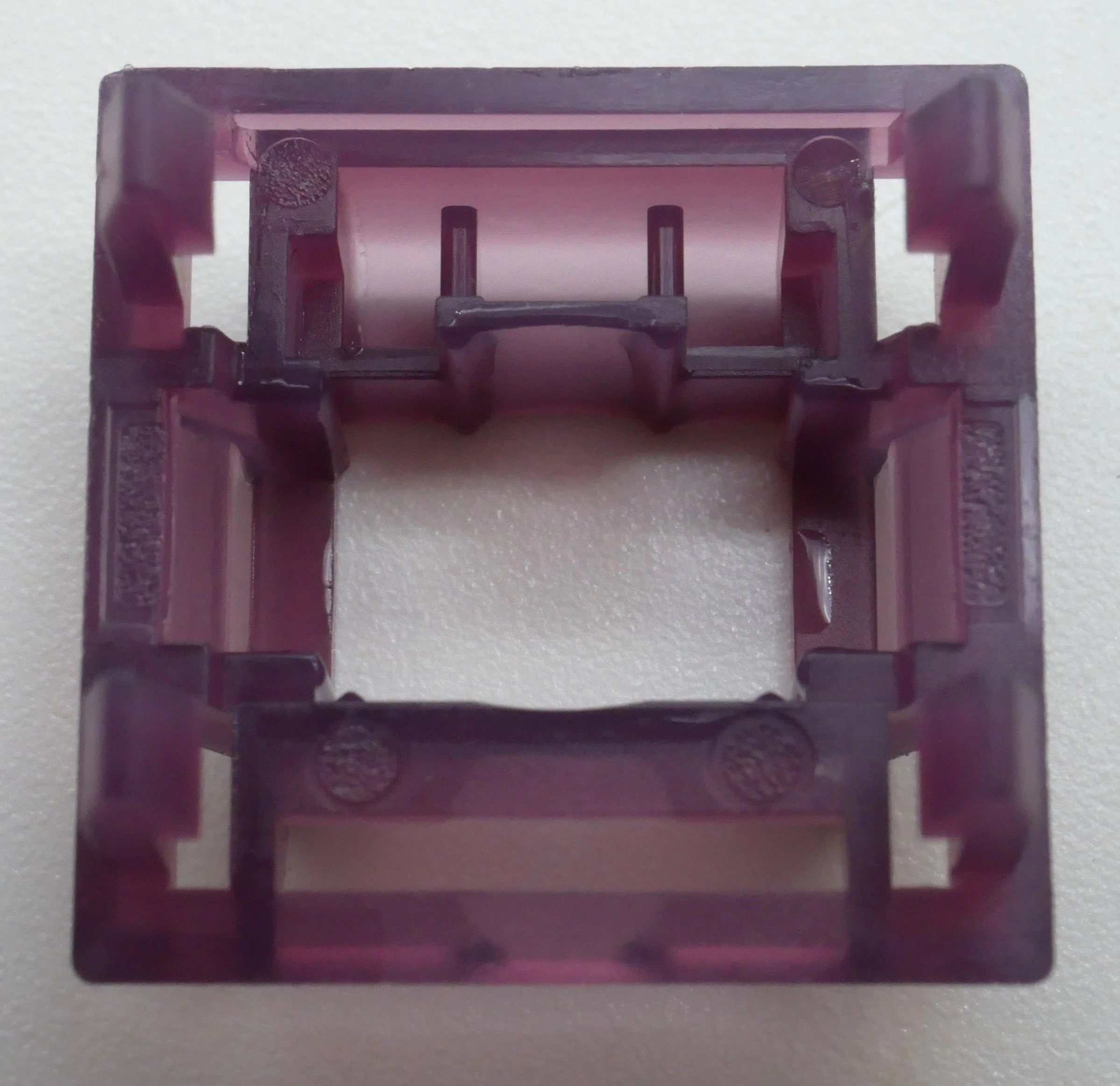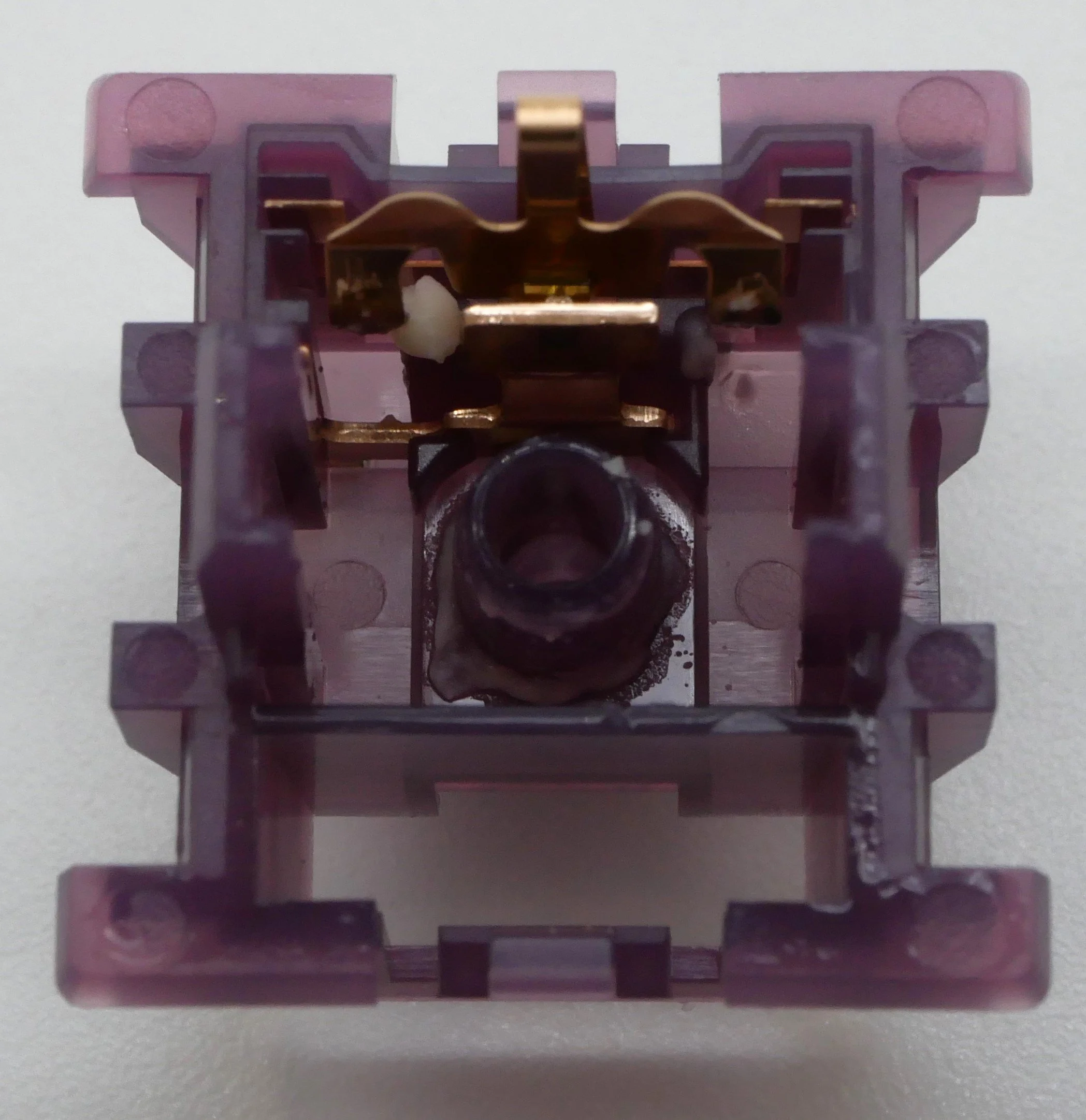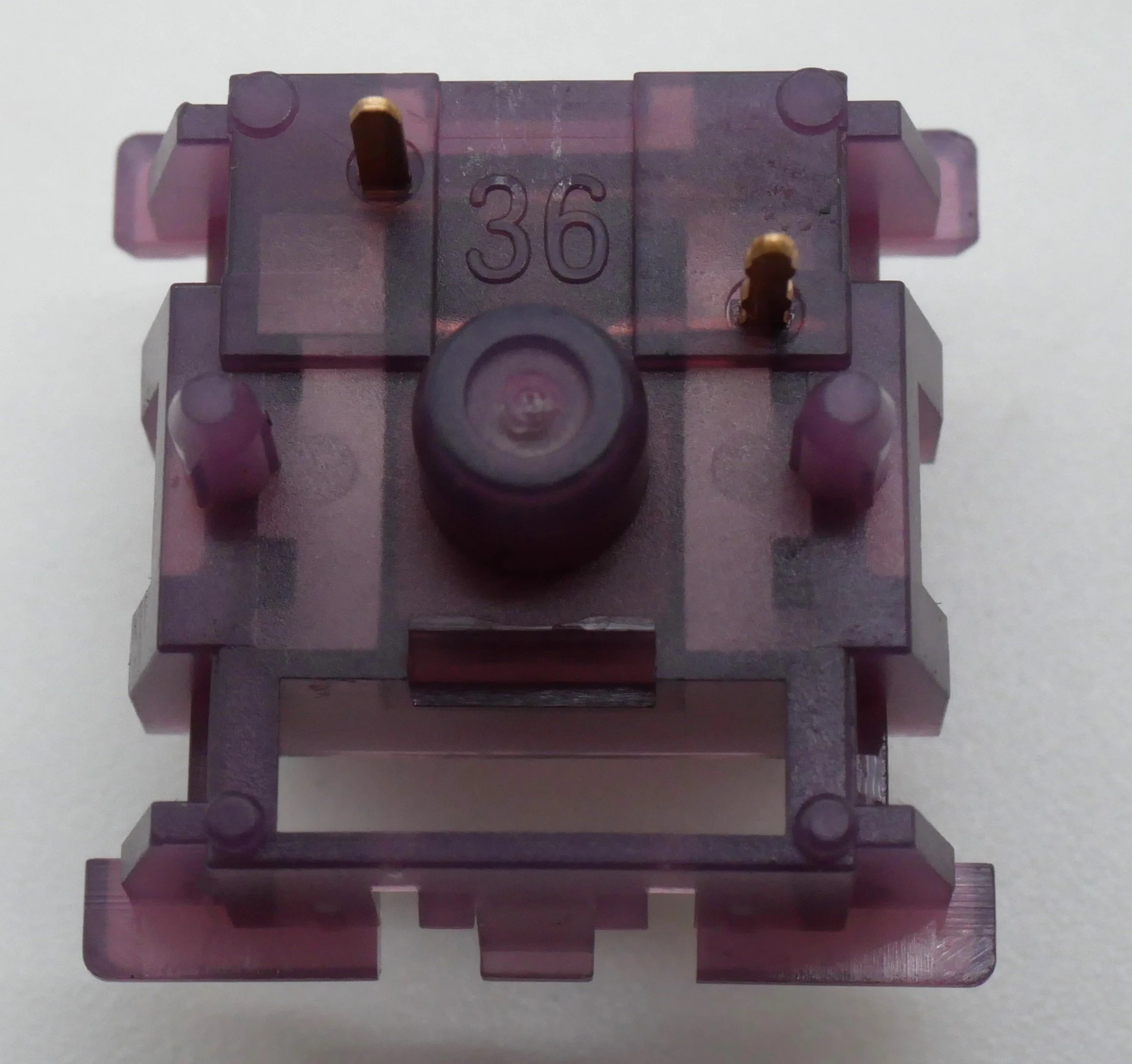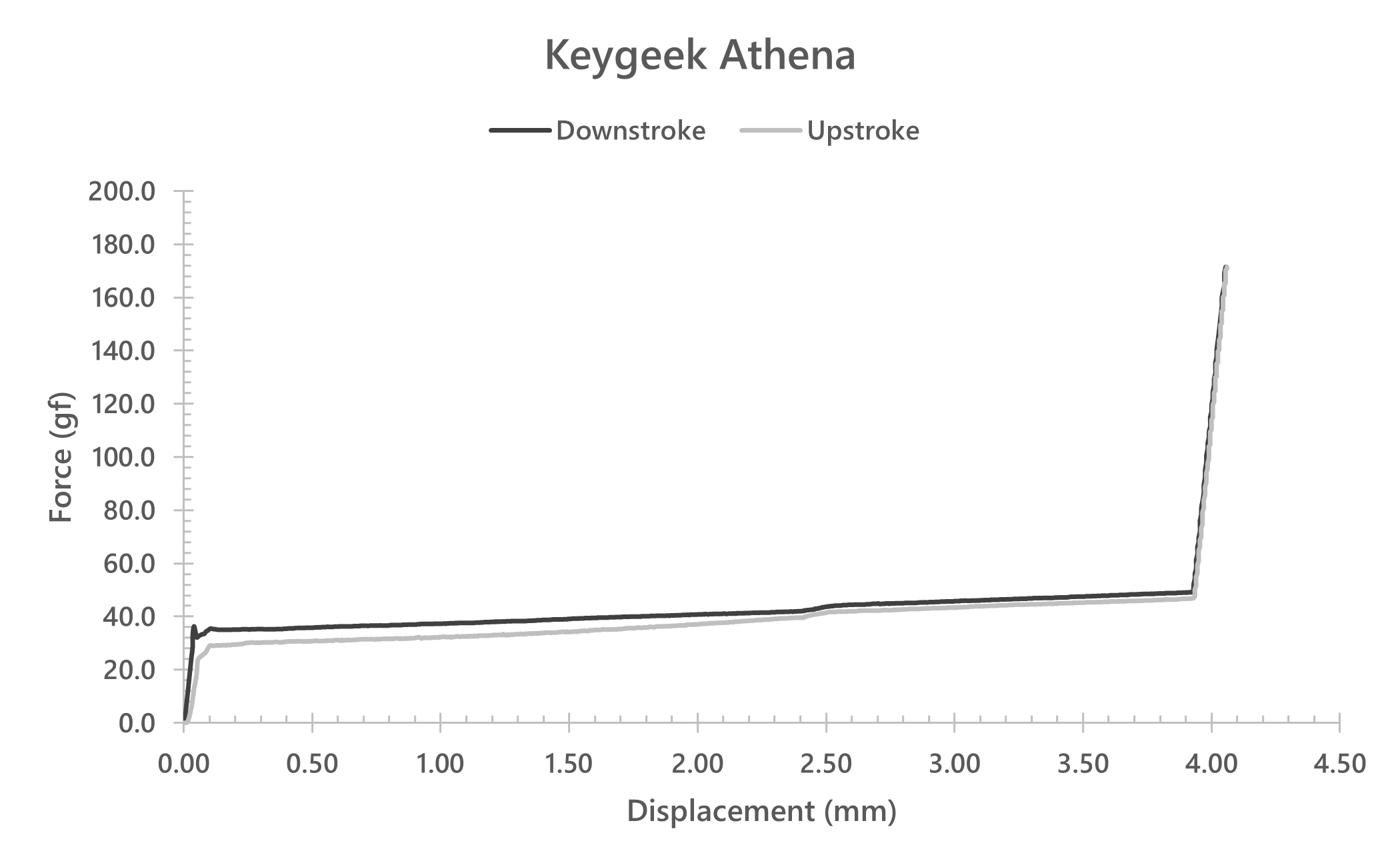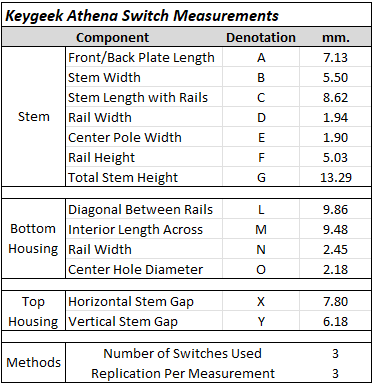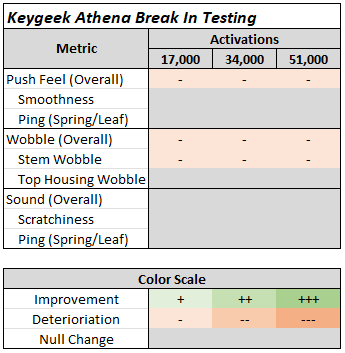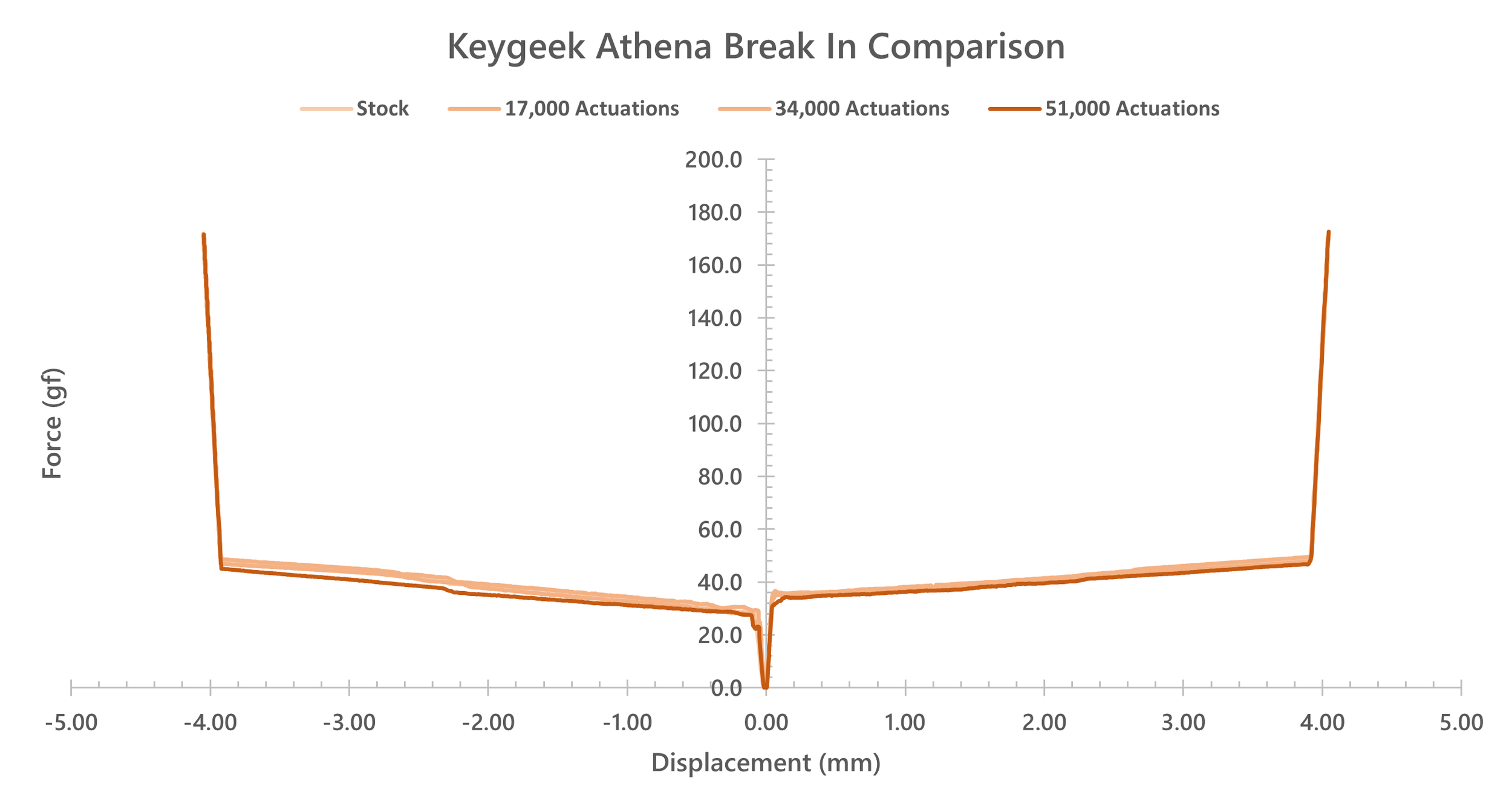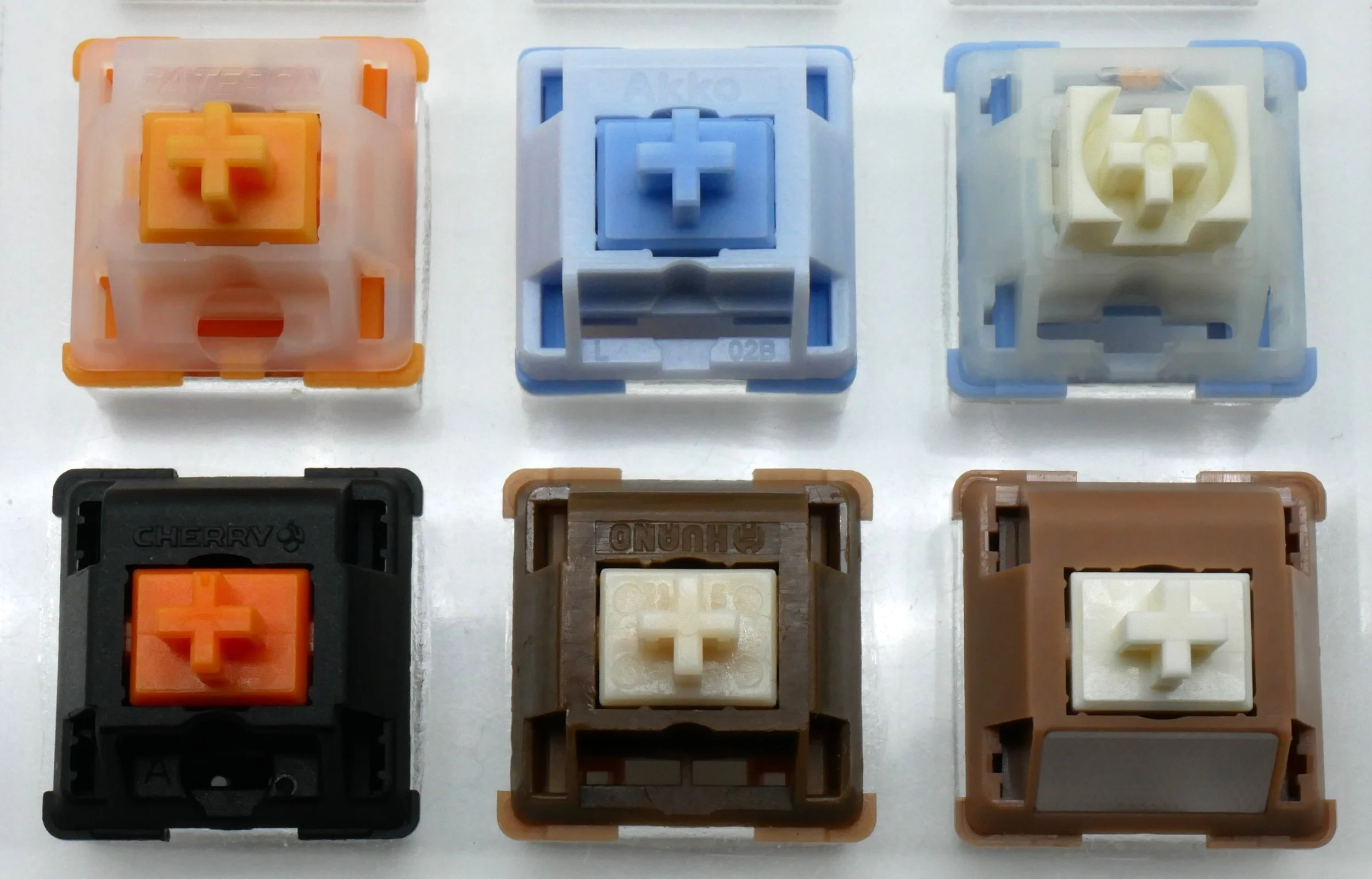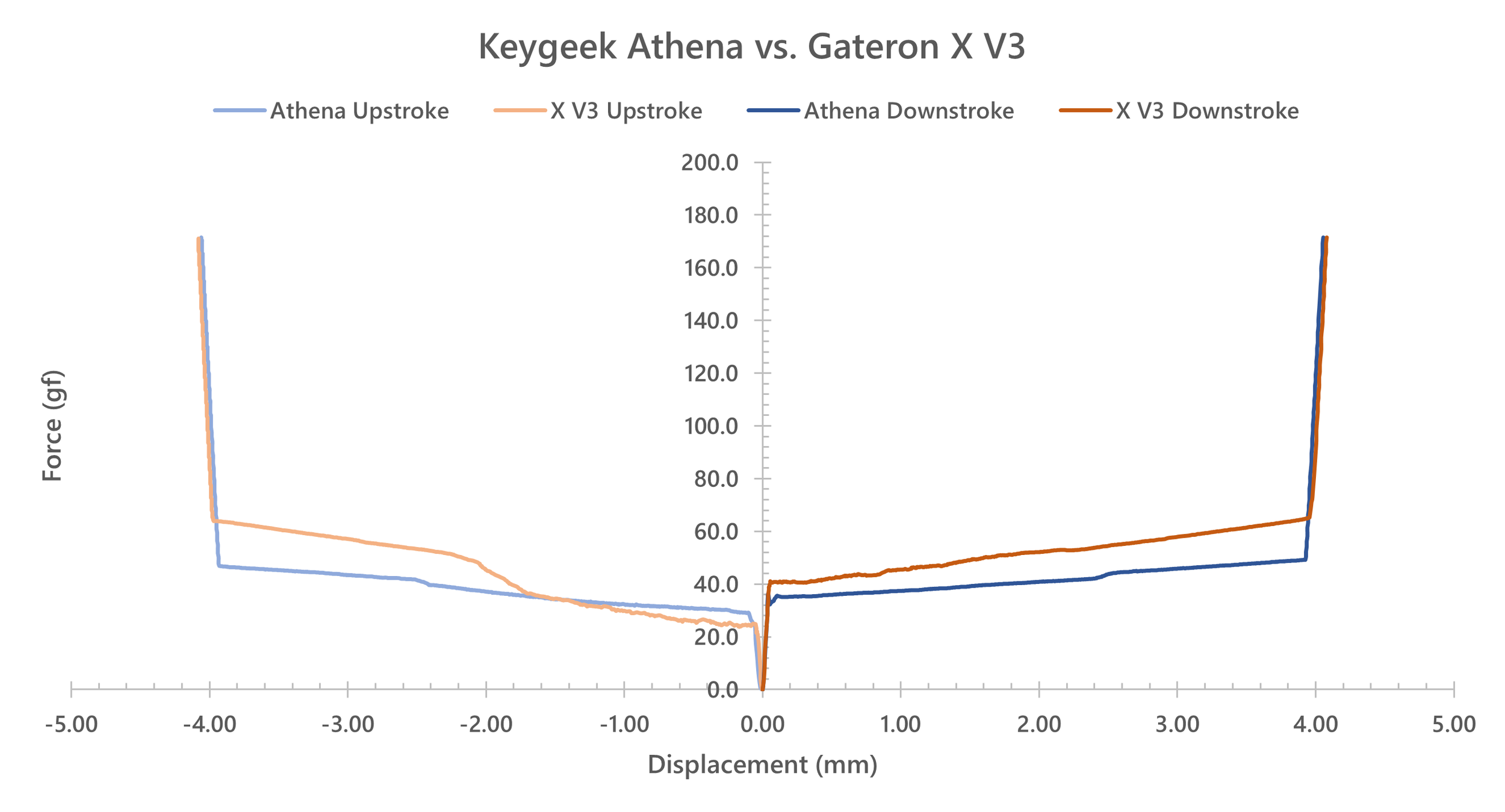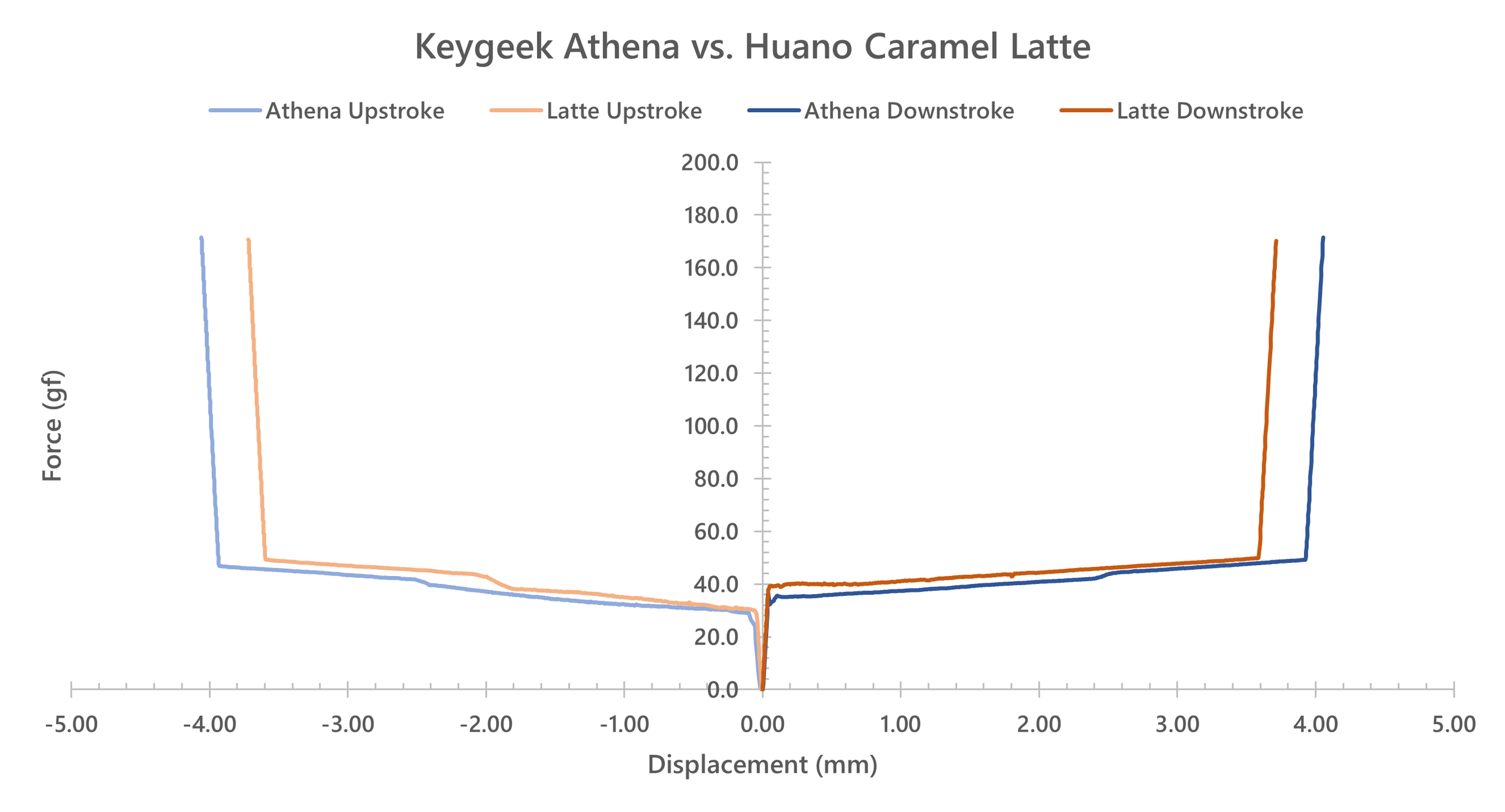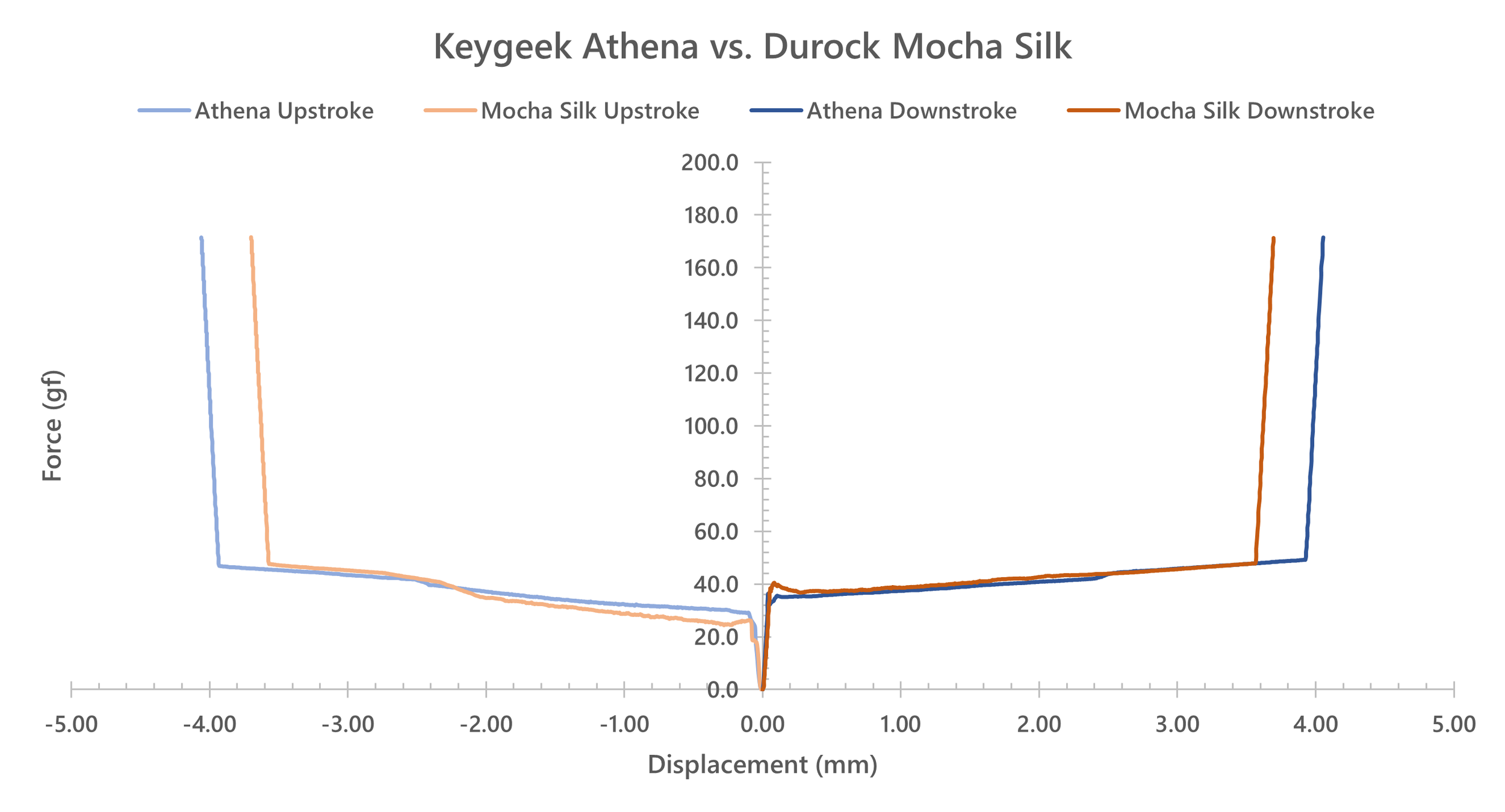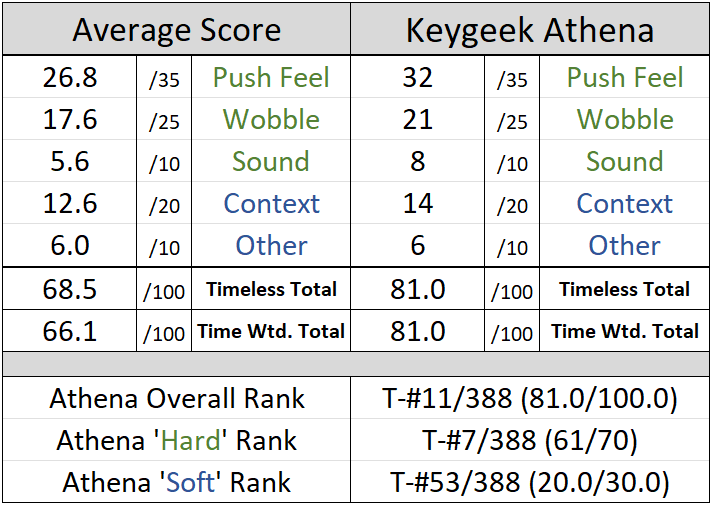Keygeek Athena Switch Review
You know what, I think I’m getting a bit tired of this whole “every single week is a crazy one” thing. I’m not sure if I have some perpetually re-upping case of bad luck or if some much younger version of me accidentally wished for an ‘interesting life’ in the wrong wishing well, but there’s just something abstract, amorphous, and strange that leads me into situations that don’t happen to other, normal people. Case in point: I landed myself in the ER last Monday night when a freshly sharpened vegetable cleaver came off of my kitchen countertop and nearly went cleanly through one of my toes on the way down. Thankfully hitting only the middle toe on one foot, it went clean to the bone, broke the joint, and only landed me nine stitches as opposed to taking multiple toes off entirely in the process. While I am doing a lot better now physically, a week or so down the road from when it first happened, I can say that I spent a good amount of time in the ER that night introspecting on if I may have accidentally just permanently maimed myself over vegetable prep work for a soup. On the more positive spin on things, though, I now have a sweet new boot that I get to walk around in for another week until I get to the podiatrist and actually confirm with a doctor that I am in fact as fortunate as I think I might be in this scenario. As well, I now know that if the keyboard hobby were to completely disappear on me tomorrow that I may be able to make some side cash from sharpening knives as I clearly seem to do a pretty solid job at that. All in all I’m doing fine now, just a bit exhausted with my string of luck lately.
As an additional small side note before I launch into the review, I am planning to once again attend Chicago’s ‘That Windy City Keeb Meet’ here in a couple of weekends on July 26th! In addition to being a volunteer and helping get stuff together for the meetup, I’ll be there with SwitchOddities and also be giving a panel presentation again on an entirely different subject than both last year’s TWCKM presentation and the Keycon talk I gave only a few weekends ago. If you’re in the area and/or have your tickets already, be sure to stop by for the interesting talk on switch variation and say hello to me in person!
Figure 1: Despite not being the biggest fan of the lime green color, myself, I have to admit that the design is pretty damn clean.
Switch Background
Given my near brush with toe death, I feel like I have a renewed outlook on life and want to lead the unpredictable remainder of it with honesty as one of my main driving goals. Resultingly, I can be honest and admit that the Keygeek Athena switches are certainly not the most interesting of switches out there as of the time I sat down to actually write this review. Hell, with the Keygeek Y2 switches rocking new “waffle stem” technology, I’d even go as far as to say that the Athenas aren’t even the most interesting Keygeek switches out there as of the time of writing. However, since the Keygeek Athenas first made their debut several months ago, I knew that they would be switches I wanted to do a full length review on because of their continuation of one of the longer running, still active switch families presently available on the market. This family of switches is also arguably among one of the better ones to have been released over that span of time as well, though admittedly it hasn’t gained nearly as much recognition on account of it being created and largely pushed by a lesser known vendor based in China by the name of Moyu Studio. (This lack of recognition is completely in spite of the fact that they are among the most accessible and western facing Chinese switch sellers out there and have regular communication via Discord, Geekhack, and other platforms.) While avid readers of reviews here on this website will recognize the name of ‘Moyu Studio’ from their linear switch collaboration with XCJZ in the form of the Moyu Studio x XCJZ Snow Grapes, I imagine quite a few others of you will recognize them by some of their switches if not by name. This not even expansive list of decently recognizable switches Moyu Studio has released since 2019 includes the BSUN Hillstone, Wikuo Harmony, Outemu Feathers, EMT V1s (which I’ve personally used in a board of mine), and Musetsus as well. I, myself, also recognize Moyu Studio’s contribution to the switch world in the Durock/JWK made Queen switches though this is entirely because of a long, somewhat complicated story that involves one very dedicated fan of them sending threats to me in public servers as a result of not liking my scoring of them… Uncharacteristically not going into depth on that one point and leaving it as a tale for another day, one of the best long running switch families that Chen, the very kind proprietor of the store, and Moyu Studio have supported and grown for so long is what has brought me to writing this review today – The Greek Mythology Series.
Figure 2: Who would have ever thought these switches would be the most contentious ones I've ever reviewed or scored?
First started with a Geekhack Interest Check page all the way back in August of 2021, the Greek Mythology Series has been a well spaced switch family seeing annual additions to its ranks on an almost clockwork frequency. With the Poseidon switches kicking things off in 2021, the first couple of the years of this family were largely produced by Durock/JWK, including the Hades and Hera switches coming about in 2022 and 2023, respectively. Sensing a change in the waters when it came to switch manufacturers as well as noticing Durock/JWK’s significantly decreasing production volume and quality towards the tail end of 2023, Moyu Studio then went on to pivot towards HMX for a reimagining of the Hades switches in 2024 and once more again towards Keygeek for the Athena switches in 2025. Each and every single one these entries didn’t just get put up for sale randomly one day on Moyu Studio’s website, though, as they’ve meticulously documented each and every one with a preceding Geekhack interest check packed to the brim with details, pricing, specs, rationale, marketing photos, a vendor list, and every single thing a documentarian like me could ever ask for. In these earliest “interest check” stages which often are months ahead of the actual release of the switches, Chen and crew even went far enough to start releasing vendor lists for the switches that support over a half dozen different regions of the world in addition to China, which they directly support. While all of these interest checks do have some strong flavor of marketing to them that earned that set of quotation marks in the last sentence, they are also quite illuminating in their descriptions and provide specific, complex insight into the thought process that went into the development of the switches – something which most vendors rarely share. This is especially evident when reading them all back to back and noticing a clear through line with all of the releases with respect to stem length and custom housing materials. Selecting the Durock/JWK P3 blend in the Hades V1s, their LY blend for the Heras, HMX’s T5 material for the Hades V2s, and even Keygeek’s U4 material blend for the Athena stems – all of which also have exaggerated or shortened stem lengths – it’s pretty evident that Moyu Studio is in pursuit of a difference in sound profile and bottom out feeling feeling than what is conventionally available on the market presently. With eight more gods left in the Pantheon of switches yet to be released, it’s rather clear that we can expect the Zeus, Hephaestus, or Hermes switches to all fit the mold of mold breaking stem materials and designs over the next half decade or so of their continued releases.
Figure 3: A very abbreviated Greek Mythology Family photo with Poseidons (Left), Hades V1 (Center), and Athena (Right) because I am apparently way behind on collecting these.
Figure 4: A table of specifications for each of the Moyu Studio Greek Mythology family of switches gathered from their respective Geekhack Interest Check pages.
To say that the Keygeek Athena switches and the broader Greek Mythology family are solely interesting because they are well documented and explore clear aesthetic and design themes over a long span of time would also be selling them both short in a broader, full historical context. To me, this family is more deeply interesting as it is one of the rare few families that have persisted long enough to see their main supporting pivot away from manufacturers due to quality dropoffs that they initially struck out on a blazing paths with. While many of you may think of Akko’s indecisiveness with vendors or of the Kinetic Labs’ Animal Family of switches examples of this phenomenon, I’m thinking of ones that are more deliberate in their pivot from one company to another rather ones that are just scattered in their interest. If you consider all of PunkShoo’s work as a “family” of releases it would be a little bit warmer here as he did a lot of early production runs with Aflion before pivoting to Gateron, though it is hard to link all of his releases together under a coherent theme. The two families which directly fit this bill of being long running and having hard pivot points due to manufacturer quality drop off is that of Dangkeebs’ Milk Family and TheKeyCompany’s (TKC’s)/C3Equalz’s Fruit Family of switches. Both spanning more than five years of time on their own, the Dankgeebs family is the more recent to have changed, having only recently pivoted away from Tecsee-made Strawberry, Banana, and Melon milk switches to that of an unknown, clearly different manufacturer for their Blueberry Milk switches. The TKC/C3Equalz Fruit Family more cleanly parallels that of Moyu Studio’s Greek Mythology Family as they too started out largely being manufactured by Durock/JWK with the Tangerines, Kiwis, and Dragonfruits prior to pivoting at the very end to Tecsee with the Blackberries as well as the unreleased prototypes which I discussed at last year’s That Windy City Keeb Meetup talk. The fact, alone, that the Greek Mythology Family has been running long enough to span a half decade is in and of itself historically interesting, though the fact that it does so through the fall off of Durock/JWK and the rise of both HMX and Keygeek as the newest, hottest switch manufacturer of the time places it at quite the crux of changing mechanical keyboard switch eras.
The Keygeek Athena switches, specifically, were first teased to the world by Moyu Studio by way of a Geekhack announcement on April 15th, 2025. Being pushed as a spiritual successor to the HMX-made Hades V2 switches from 2024, the Athena switches were to be produced by Keygeek using their matte housing molds and boasting Keygeek’s proprietary plastic ‘U4’ blend for their long, stem pole bottom out stems. Reportedly coming in two different weights – 42g and 58g – these linear switches come pre-lubed from the factory, feature purple nylon housings, and were to be sold by a wide array of vendors including Divinikey in the US, Max Gaming in the EU, Thocc Exchange in the UK, and quite a few others at a listed price of $0.35 per switch plus or minus a few cents for regional market variations. While it has been quite some time since I’ve last spoken to Chen or anyone at Moyu Studio, recalling their general excitement about each of their other previous releases in the Greek Mythology Family of switches, I’d be hard pressed to imagine these won’t be supported for quite some time in the future. Despite the previous Greek god iterations being discontinued by Moyu Studio after a couple of years in their limelight, their annual additions to this family and long support for each switch over the couple of years while they are relevant likely means tha the Athenas will continue to be supported and around for at least a few more years into the future.
Athena Performance
Note: The Keygeek Athena switches which are described in the sections below is that of the ~42g. weighting. I was not able to obtain the 58g. version of these switches for the collection by the time in which the review was written. To the best of my knowledge, there is no aesthetic difference between the two weightings, despite the Hades V2 switches previously having differently colored stems for their different weightings.
Appearance
At the highest level, the Keygeek Athena switches come in a luxurious translucent and matte purple housing with well contrasted lilac purple stems that form a combination that has almost certainly never been done before. While it is ultimately simplistic relative to the increasingly insane designs that mechanical keyboard switches have taken on in recent years, I have to admit that it is quite captivating and arguably one of my favorite colors I’ve ever seen on a switch before. Despite my fondness for such, I can’t say that I exactly would have connected this shade/tone of purple with Athena of all of the Greek gods, though. I would have more readily ascribed purple to the likes of Aphrodite and red to Athena, though then again I also wouldn’t have thought of green for Hades, either. Perhaps I’m just not nearly as read up on the Greek mythos as I should be. What I am well-read up enough on, though, is plastics manufacturing and so I can say that the visually stunning matte effect that Keygeek shows off here (and has shown off previously in the Keygeek Oat Switch Review) is caused by an extremely subtle injection mold texturing which leads to the surfaces of the housing parts having more diffuse reflections than specular ones after forming. While as simple of an effect as the color choice, the combined execution here is fantastic and delivers an overall aesthetic punch. Beyond just the color and finish of these switches, though, there are a good few Keygeek details worth pointing out and discussion of these sub-part features may be found in the paragraphs and photos below.
Figure 5: Keygeek Athena switches and their components.
The translucent, matte royal purple nylon top housings of the Keygeek Athena switches well match up with the design details and specs that Keygeek has touted in their other switches throughout their short rise up the switch manufacturer totem pole. While they haven’t been around nearly as long as some more established factories that have been forced into redesigns over time, Keygeek’s steadfast dedication to specific identifiable design details like their small, blank rectangular nameplate “logo”, their long thin LED/diode slot with centered circular indentation and numerical mold marking, and internal matte ejector circles on the interior of the housing is quite impressive. All of these details were seen identically in the top housings of the Keygeek Oat switches in their full length review, even down to a very similar sort of opacity in the housing color as well. Unlike the Keygeek Oat switches, though, the presence of trace amounts of factory lube is more obvious in the Keygeek Athenas due to the contrast between the purple color and that of the milky white colored factory lubing. Overall, though, the majority of the lube is concentrated in the base of the bottom housings of these switches as can be seen in the photos further down in this section.
Figure 6: Keygeek Athena top housing exterior showing small, blank rectangular nameplate logo and sideways, single number mold marking located on the inner edge of the LED/diode slot.
Figure 7: Keygeek Athena top housing interior showing trace amounts of factory lubing and textured mold ejection marks in line with quite a few other previously released Keygeek switches to date.
Moving next to the lilac colored stems of the Keygeek Athenas, I can say that these are definitely not pink colored as the initial marketing for these switches would suggest, and are instead a very light, pale lilac/lavender color. Overall, the design of the Athena stems is one that is rather simple and has hardly anything unexpected or unknown about it save for the composition of Keygeek’s mysterious “U4” plastic material. The stems feature full length, non-tapered slider rails, mold ejector circles on the front plate of the stem above its linear legs, and a double-tiered center pole that is only barely longer than the average at 13.29 mm in total length. In addition to all of these expected and commonplace features, there’s trace amounts of factory lubing on all faces of the stems that I inspected. This, however, will likely not be able to be easily seen in the photos below as the lube is fairly light in viscosity and easily wipes off on the fingers when handling the stems.
Figure 8: Keygeek Athena stems showing non-tapered slider rails, double tiered center poles, mold ejector circles on the front plates, and a decent amount of white factory lubing on stem legs.
Finally arriving to the matching translucent, matte royal purple nylon bottom housings of the Keygeek Athena switches, we’re finally granted with at least a single detail that is different than what I’ve seen from previous Keygeek switches. This lone detail of difference is that of the double digit mold marking located on the exterior of the housings. While located in the usual place between the metal PCB pins, the number is ‘upright’ relative to the center pole hole of the housing and consists of quite large, raised text numbers – larger and more pronounced than really any other marking I recall having seen in any other switches for quite some time. Moving past this new detail and the PCB mounting pins on the underside of the housings, the Keygeek Athena bottom housings also have an interesting internal view on account of their massive amount of factory lubing trapped in the ring around the center pole hole in the base of the housing. Upon first seeing this it was so stand out that I almost believed it to be a plastic dampening ring before closer inspection. Beyond that wild amount of factory lubing that is missing from the rest of the parts of the stem it should be lubricating, the bottom housing interiors are fairly standard with a centered, raised rectangular region, no dampening pads at the base of the slider rails, and tiny mold ejector circles which can be seen in between the slider rails and the center pole regions.
Figure 9: Keygeek Athena bottom housing interior showing mold ejector circles, undampened slider rails, a raised rectangular column along the base of the housing, and generous amounts of factory lubing everywhere.
Figure 10: Keygeek Athena bottom housing exterior showing PCB mounting pins and a large, two digit numerical mold marking located between the metal PCB pins. Note that this is significantly more prominent than some other Keygeek mold markings noted previously.
Push Feel
With all of the deliberate planning put into the material choices and stem designs of all of the Greek Mythology Family of switches by Moyu Studio, you’d have to assume that their selection of nylon housings and slightly elongated, Keygeek U4 material stems would mean that Moyu Studio was shooting for deep, firm, and very hefty feeling linear switches. If I have correctly intuited their initial desires in designing this switch rather than just post-hoc rationalizing it based on my observations, I’m glad to report that they did extremely well in delivering a linear that met those initial design goals. At either end of the stroke, the Keygeek Athena switches produce deep, well balanced, and ever so slightly pointed housing collisions that are firm but still pack just enough of a ‘pop’ feeling to let you know that they are there. Even though these housing collisions are a bit inconsistent due to the factory lubing not being the most well distributed among the parts of the switch, where it is successfully and evenly applied these switches come across as one of the better iterations of a well lubed, nylon housing linear that I’ve seen in quite some time. Additionally in their favor, the Athenas feel quite true to their measured values and force curve below, feeling like they are just ever so slightly short of a full conventional stem travel and medium to light in their bottom out weight. I suppose if I had to be a touch picky about that statement, though, I’d say these switches feel ever so slightly heavier than their ~49-50 gf. bottom out weights, though I sincerely think that this can be chalked up to the factory lubing of the switches – something which deserves its own paragraph below.
Figure 11: Force curve diagram for the stock Keygeek Athena switch.
Even though the housing collisions and other previously mentioned features of the Keygeek Athenas are rather well done and will certainly be highlights for almost anyone who tries them out in a build, I can imagine that the factory lubing of the linear region in between the topping and bottoming out will be where the polarization of opinions occur. Forget what your eyes told you from the visual distribution of factory lubing across the various parts of this switch above – the Keygeek Athenas feel very heavily lubed all over. I mean that statement insofar that they come across as among the thickest, most substantially lubed light to medium weight linear switches I’ve felt in quite some time and it almost pulls up memories, in a way, of the original Durock/JWK-made Alpaca switches from many, many years ago. This degree of factory lubing, which can feel quite a bit sluggish when paired with a relatively light and airy weighted bottom out ~49 gf., can and will make or break these switches for some users. Even more so polarizing for those among us who enjoy this degree of factory lubing is the fact that the Athenas don’t have the most great consistency on this point either. While there is by no means a wild, drastic swing in thickness across the batch that I received, a good few switches are noticeably thinner and thus feel quite a bit less substantial under finger than the average Keygeek Athena switch.
Sound
With a substantially thick nylon housing and heavy factory lubing being among the main drivers in the push feeling notes above for the Keygeek Athenas, you should pretty well have the expectation already in place that these are deep, heavy sounding linear switches that just don’t make all that much noise. Yes, even despite their fairly light weighting that would normally lead to more noise with people bottoming out on them harder. Ranging everywhere from very slow typing speeds all the way up to record levels of “oh shit, my essay is due in ten minutes and I’m only halfway done” these switches are quite quiet and only really modulate in tone through their bottom out – which shifts only in its volume, not its sharpness, harshness, or even pitch at different typing speeds. The housing collisions, factory lubing, and really all other aspects of the Keygeek Athena switches remain static irrespective of typing speed with a thick, enveloping, and rich depth that really drives home why this combination of features was so successful for so long in the keyboard community. In trying them here for this review it comes across incredibly refreshing and somewhat nostalgic as Moyu Studio’s focus on producing a deep, bass-y sounding switch stands in pretty strong contrast with a community that has seemingly been focused in recent on really long stem poles, aggressive bottom outs, and proudly prominent sounding linear switches – something which was historically not always been as popular. The Keygeek Athenas sound substantial; There’s no spring ping, no scratch, no weird high pitched tones, and really only the same sort of occasional thin inconsistency that was noted above if I had to be picky and provide a point of contention with how they sound.
Wobble
The Keygeek Athena switches have a tiny though not really problematic amount of N/S and E/W direction stem wobble. Oddly enough, just like the Keygeek Oats before them there is some degree in variation on this metric across the batch of switches that I received, however it is seemingly always in the direction of outliers having less stem wobble than more.
Measurements
If you’re into this level of detail about your switches, you should know that I have a switch measurement sheet that logs all of this data, as well as many other cool features which can be found under the ‘Archive’ tab at the top of this page or by clicking on the card above. Known as the ‘Measurement Sheet’, this sheet typically gets updated weekly and aims to take physical measurements of various switch components to compare mold designs on a brand-by-brand basis as well as provide a rough frankenswitching estimation sheet for combining various stems and top housings.
Figure 13: Numerical details regarding the force curves for the stock Keygeek Athena switches.
Have you ever wanted to be bombarded with more switch data than you’ve ever seen at any point in your life before? Consider checking out the ‘Force Curve Repository’ hosted on my GitHub that contains all force curves that I take both within and outside of these full-length reviews. In addition to having these graphs above, I have various other versions of the graphs, raw data, and my processed data all available for over 1500 different switches for you to use however you see fit. Check it out via the ‘Archive’ tab at the top of this page or by clicking any of the force curve cards above.
Break In
Break In Notes
17,000 Actuations
- After 17,000 actuations, the Keygeek Athena switches did not appear to really change all that much compared to their initial, right out of the box form. The only minor differences that I could notice were slight increases in the variety of tones and feelings at bottom out across the batch of switches, though this still is quite small relative to what I’ve seen with other switches before.
- Additionally, there was a very slight increase in both N/S and E/W direction stem wobble in the Keygeek Athenas after having been broken in this far.
34,000 Actuations
- Surprisingly, after an additionally 17,000 actuations the Keygeek Athena switches did not appear to adjust, shift, nor really change at all compared to the batch that was initially broken in to 17,000 actuations. I was not able to distinguish the 34,000-actuation batch of switches from the 17,000 actuation one.
51,000 Actuations
- Even more surprising is that the Keygeek Athenas did not shift anymore beyond that initial break in period, leaving both the 51,000 and 34,000 actuation lot to effectively feel the same as the first lot. While it’s not uncommon for switches to remain consistent from one section to the next, it’s been quite a while since I had a switch that managed to make it through the last two break in periods without morphing at all.
Figure 15: Comparative force curve diagram showing no substantial change in the force curves of the Keygeek Athena switches throughout the break in process.
Comparison Notes to Other Notable Linear Switches
Note – These are not aimed at being comprehensive comparisons between all factors of these switches as this would simply be too long for this writeup. These are little notes of interest I generated when comparing these switches to the Keygeek Athena switches side by side.
Figure 16: Switches for comparison. (L-R, Top-Bot: Gateron X V3, Akko Mirror, SWK Ripple, Cherry MX Orange, Huano Caramel Latte, and Durock Silk Mocha)
Gateron X V3
- There is a fair bit less stem wobble in both the N/S and E/W direction of the Keygeek Athena switches than there is in the Gateron X V3 switches, which is not altogether unsurprising when you recall that the X V3 molds are multi-year old Gateron designs and the Athenas are produced from relatively newer Keygeek molds.
- Despite what the comparative force curve below would suggest, the Gateron X V3 switches actually feel as if they have a stroke length that is quite a bit longer than that of the Athena switches. While I am not entirely sure why this would be the case, it’s entirely possible that this difference in feeling could be due to their gap in bottom out weight.
- In terms of out of the box smoothness, both of these are smooth linears though they exist at opposite ends of the ‘lubed switch’ spectrum. Whereas the X V3 switches have a light, evenly coated, and precise factory lubing application, the Keygeek Athenas feel thicker, heavier, and almost as if they were lubed by hand by comparison.
Akko Mirror
- In terms of their sound profiles, the Akko Mirror switches are louder, higher pitched, and bit more forward sounding than the Keygeek Athenas as a result of their rather head-on striking of their stem poles. The thick nylon housings and factory lubing of the Athenas, by comparison, make them sound much deeper and bass-heavy in their tone.
- The Akko Mirror switches have less N/S and E/W direction stem wobble than the average Keygeek Athena switch.
- Similar to the note above about the Gateron X V3 switches, the Akko Mirrors and Keygeek Athena switches are both smooth linears though exist at completely different ends of the ‘smooth’ spectrum.
SWK Ripple
- Even though the SWK Ripple and Keygeek Athena switches have fairly similar bottom out weights to one another, the SWK Ripples feel much more heavy and forceful at the end of their strokes as a result of their solid striking stem poles that dominate their bottom outs.
- The SWK Ripple switches also have a fair bit less N/S and E/W direction stem wobble than the Keygeek Athena switches. (It should be noted that the Akko Mirrors, above, and the SWK Ripple switches were among some of the best in terms of stem wobble metric in recent times.)
- As a result of the stem pole bottom out of the SWK Ripple switches, they sound much more sharp, pointed, and high pitched than that of the Keygeek Athena switches. The Athenas are much more quiet, subtle, bass heavy, and soft in their housing collisions even despite the slight presence of their stem poles at faster actuation speeds.
Cherry MX Orange
- The generous factory lubing on the Keygeek Athena switches makes them feel much smoother than the stock Cherry MX Orange switches, even despite the improved MX2A platform factory lubing of these switches.
- The Keygeek Athena switches have a fair bit less N/S and E/W direction stem wobble than the Cherry MX Orange switches, and even in spite of the improved molds used as part of Cherry’s MX2A design platform.
- While I believe the comparative force curve between these two switches is fairly accurate, I want to highlight the left-hand side of the plot in the upstroke region for once as I feel like the difference in the curves actually shows up in hand. Despite being similarly weighted once the PCB leaves re-engage, that strong downward arc in that curve of the MX Oranges really makes them feel much more ‘springy’ or ‘snappy’ in their upstroke return than the Keygeek Athenas.
Huano Caramel Latte
- Of all of the switches on this comparison list, the Huano Caramel Lattes and the Keygeek Athenas are the most similar in terms of their overall volume and sound profile. Likely due to their generous factory lubing on both ends, these switches are both quiet, bass focused, and have the tiniest bits of bottom out that poke through at higher actuation speeds.
- There is slightly less stem wobble in both the N/S and E/W directions of the Keygeek Athena switches than there is in the Huano Caramel Lattes.
- While the comparative force curve below only does show a gap of approximately 0.40 mm between their total stem travel distances, in hand these switches both feel like they travel more or less the same amount. Without me being able to crutch an answer on differences in their bottom out weighting as it is extremely similar, I honestly have no idea why this would necessarily feel that way.
Durock Mocha Silk
- The factory lubing on the Durock Mocha Silk switches is a noticeable bit lower in quality than the Keygeek Athenas, with the occasional thin spot showing up in its stroke leading to very subtle scratchy spots that are just simply not present in the Keygeek Athenas because of their generous factory lubing.
- The Keygeek Athena switches have less N/S and E/W direction stem wobble than the Durock Mocha Silk switches.
- Of all of the switches on this comparison list, I feel like the comparative force curve between these two switches below is the most accurate. The stem pole bottom outs of the Mocha Silk switches are much more noticeable than the Athenas and resultingly makes the Mocha Silks feel that much shorter in their stem travel.
Linearity
Figure 23: Absolute and relative Linearity and Slope values for each switch in this comparison section.
Figure 24: Qualitative comparison of the normalized Slope and Linearity for each switch in this comparison section.
If you are just now seeing this section for the first time and are a bit confused as to what I am talking about when discussing ‘Slope’ and ‘Linearity’, I highly suggest checking out my article titled ‘On Differences in Linear Switches’ where I explain what this section is for and how it came to be! For a bit of a shorter answer, know that this is part of my ongoing attempt to better quantify and articulate differences between linear switches which have historically not been captured in discussions about them.
Scores and Statistics
Note – These scores are not necessarily completely indicative of the nuanced review above. If you’ve skipped straight to this section, I can only recommend that you at least glance at the other sections above in order to get a stronger idea of my opinion about these switches.
Push Feel
The Keygeek Athena switches are medium-light weight linears with nylon housings, Keygeek’s U4 material stems, and a whole lot of factory lubing that insulates them and gives them a thick, rich, and very muted feeling despite their other metrics. With no scratch, no spring ping, and really nothing but an overly smooth up and down feeling as a result of the lube, there is one small contrasting point to the feeling of the switches that comes by way of the slight bottoming out onto the stem pole. While slightly prone to inconsistencies and some variation across typing speeds, even this is subtle and does well to support the compact and soft feeling of the Athenas.
Wobble
The Athena switches have very little N/S and E/W direction stem wobble that is surely unlikely to bother most if any users unless they are particularly picky about their stem wobble.
Sound
Deep, rich, bass heavy, and soft in all of the right places, the Keygeek Athena switches are a prime example of just how elegant a generous amount of factory lubing can be when it avoids squishiness or inconsistent tones. Accented by slight pop from the bottom and topping out of the stem pole, these switches sound firm, tight, and easy on the ears for both you as the user and anyone else in the room while you’re using them.
Context
Priced at $0.35 per switch and available through a half dozen different vendors across the globe, Moyu Studio has done everything they can to make these switches as accessible as possible despite the community not nearly paying enough attention. These will very likely be around for quite a few years to come and are an excellent display of the Keygeek’s custom capabilities.
Other
While the Athenas are not nearly as daring as some other entries, they prop up and continue a half-decade long Greek Mythology switch family and are deserving of their credit as a result.
Statistics
If you are looking at this statistics section and wondering what the heck happened since the last review, consider checking out my short article titled ‘A Scorecard Time Change’. Moving forward, switches are now ranked in this statistics table using a “time weighted total” as opposed to their day-of scoring as discussed in that article. If you’d also like to learn about what ‘hard’ versus ‘soft’ ranks refer to specifically, I’d encourage you to head on over to my GitHub linked in the table above or at the links in the top right hand of this website to check out my database of scorecards as well as the ‘Composite Score Sheet’ which has a full listing of the rankings for each and every switch I’ve ranked thus far.
Final Conclusions
On the whole, the Keygeek Athena switches are rather strong performing medium to lightweight linear switches at the $0.35 per switch price point they are propped up at. They have firm, solid housing collisions with just the slightest amount of pop that makes their presence feel known on either end of consistently smooth strokes that don’t change much across the batch of switches nor through different actuation speeds. Even more refined and deliberate in the design of the Athenas is that of their sound, which is dark, quiet, and really bass heavy where focused and is largely driven by the insulating effect of a generous amount of Keygeek factory lubing. And yet despite having a pretty heavy handed amount of this lube laid down, the switches don’t really seem to suffer with gumminess, large inconsistent gaps, or any real negative tones. The factory lubing just feels all-encompassing and well enough applied that it surely would have fetched a premium well over the $0.35 per switch price point if they were released a handful of years ago. What makes all of these features extra impressive is that it is done with relatively simple design tweaks and choices by Chen and the team at Moyu Studio – a slightly different stem length here and a sprinkle of U4 stem material in an otherwise nylon housing construction there. This review started of emphasizing the historical implications of the Keygeek Athenas and how they continue a half-decade long switch family that has been successful in the grand scheme of things but also criminally underappreciated by the community at large, and yet at the tail end of the review I feel like I’ve come away with something completely different than contextual appreciation. I’ve gained a deeper appreciation of just how much simple measures and adjustments can make the differences between good and really good switches. In a switch market that is ever increasing in complexity from new aesthetic concepts, new technologies, or entirely from-ground-up mechanism redesigns, sometimes nailing the fundamentals can make a switch stand out beyond those gimmicks just a bit more than you think they would. To me, the Keygeek Athenas are those elegantly nailed linears that just stand out a bit more than you’d think on paper.
Sponsors/Affiliates
Mechbox UK
- A wonderful UK based operation which sells singles to switches that I’ve used above in my comparisons for collectors and the curious alike. Matt has gone out of his way to help me build out big parts of my collection, and buying something using this link supports him as well as my content!
KeebCats UK
- A switch peripheral company based out of the UK which sells everything switch adjacent you could ask for, they’ve been a huge help recently with my film and lube supply for personal builds, and they want to extend that help to you too. Use code ‘GOAT’ for 10% off your order when you check them out!
proto[Typist] Keyboards
- An all-things keyboard vendor based out of the UK, proto[Typist] is a regular stocker of everything from switches to the latest keyboard and keycap groupbuys. While I’ve bought things from the many times in the past, they also are a sponsor of my work and allow me to get some of the great switches I write about!
Divinikey
- Not only do they stock just about everything related to keyboards and switches, but they’re super friendly and ship out pretty quick too. Divinikey has been a huge help to me and my builds over the last year or two of doing reviews and they’ll definitely hook you up. Use code ‘GOAT’ for 5% off your order when you check them out!
ZealPC
- Do they really need any introduction? Zeal and crew kicked off the custom switch scene many years ago with their iconic Zealios switches and the story of switches today couldn’t be told without them. Use code ‘GOAT’ (or click the link above) for 5% off your order when you check them out!
MechMods UK
- A rising vendor based in the UK, Ryan and crew have been a pleasure to work with and have nearly everything you’d need to build your first or fourteenth keyboard. Go build your latest or greatest one right now with them by using code ‘GOAT’ at checkout for a 5% discount!
Dangkeebs
- A longtime supporter of the website and the collection, Dangkeebs has quite possibly the widest variety of switches of any vendor out there. Not only is their switch selection large, but it rotates and is constantly adding new stuff too. You’re going to need 5% off your order with my affiliate to save off the cost of all those switches!
SwitchOddities
- The brainchild of one my most adventurous proxies, SwitchOddities is a place where you can try out all the fancy, strange, and eastern-exclusive switches that I flex on my maildays with. Follow my affiliate code and use code ‘GOAT’ at checkout to save 5% on some of the most interesting switches you’ll ever try!
Cannonkeys
- Does anybody not know of Cannonkeys at this point? One of the largest vendors in North America with keyboards, switches, keycaps, and literally everything you could ever want for a keyboard always in stock and with an incredibly dedicated and loving crew. Follow my affiliate link above in their name to support both them and I when you buy yourself some switches!
Kinetic Labs
- One of the most well-rounded keyboard vendors out there, Christian and crew have been supporters of all my switch and switch-adjacent needs for some years now. I’m honored to have them as an affiliate and think you should check them out using my affiliate link above to support both them and I when you check out their awesome products!
Keebhut
- Want to try out some switch brands that fly under most vendor’s radars? Keebhut is always seeking out that next latest and greatest and has been super helpful in hooking me up with new brands over the past year. They are all about sharing that love as well, and want to give you 5% off your next order with them when you use code ‘GOAT’ at checkout!
Kailh
- No, you’re not mistaken – this is actually that Kailh that manufactures switches. As one of the longest running manufacturers in the hobby, they have a massive variety of switches available over on their website at any point in time. I’m lucky to be affiliated with them now, and so consider using my affiliate link above when ordering some Kailh switches to support me!
Keebz N Cables
- Australia and Oceania’s very own is now a part of the sponsor list here and I couldn’t be happier to add this long time supporter of the collection to it. They’ve always got an amazing selection of switches (and other keyboard parts) in stock and they want to share the love that they’ve shown me with you all too! Use code ‘thegoat’ for 5% off your first order when you visit!
Further Reading
Moyu Studio’s Poseidon Geekhack IC Page
Moyu Studio’s Hades Geekhack IC Page
Moyu Studio’s Hera Geekhack IC Page
Moyu Studio’s Hades V2 Geekhack IC Page
Moyu Studio’s Athena Geekhack IC Page
Divinikey’s Keygeek Athena Sales Page
Max Gaming’s Keygeek Athena Sales Page

